Our 2019 Honda Civic Type R Forced Us to Overlook Its Faults
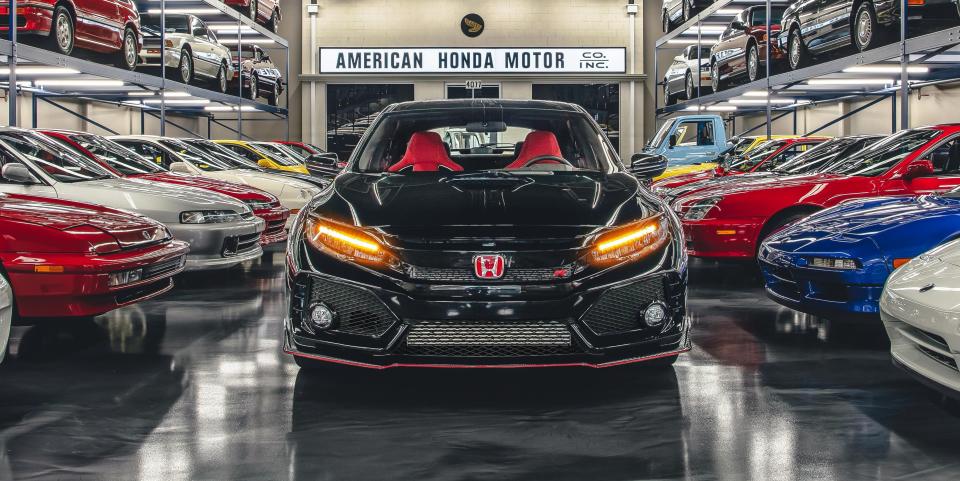

40,000-Mile Wrap-Up
After feeling the Civic Type R's incredible ferocity, the sports-car-shaming directness of its steering and especially its brakes, it'd be natural to assume that Honda, in the quest for this level of tenacity, would have ditched the back seat and installed a huge strut-tower brace in the cargo area. Furthermore, you'd expect the high-state-of-tune 306-hp turbo 2.0-liter to guzzle oil and require more frequent servicing. But that's not the Honda way.
This latest Type R, only the second vehicle wearing the vaunted red "R" badge to be sold in the United States, has just as generous a back seat as every Civic (albeit with one fewer seat) and the largest cargo hold among compact hatchbacks. It may have appeared strange to see us loading a half-dozen bags of mulch into the back of the car that currently holds the front-drive record at our annual Lightning Lap track shootout at Virginia International Raceway. But the Type R, giant wing and all, retains all the functionality of any Civic.
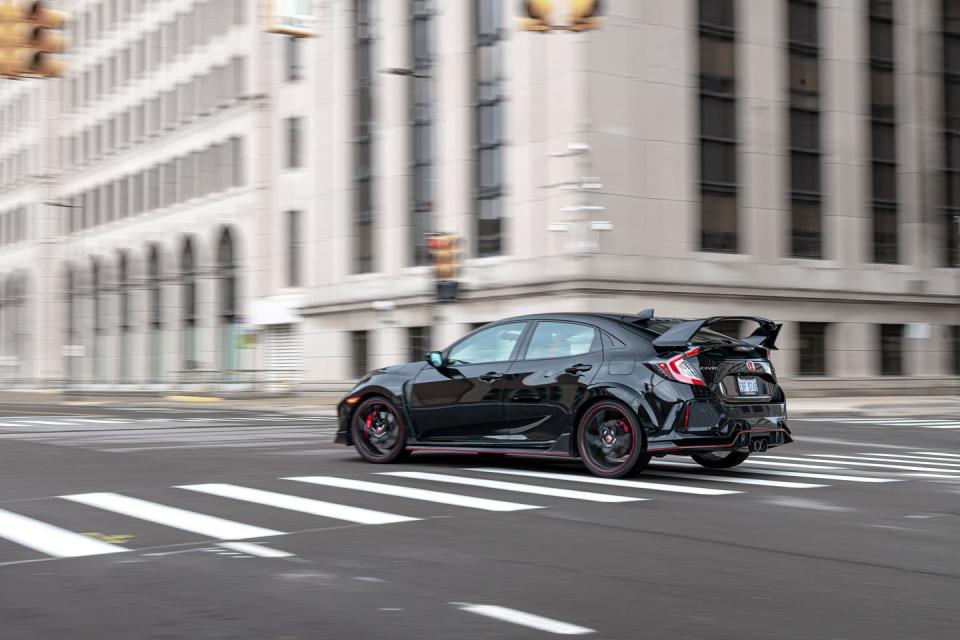
True to that ethos, there's no Type R–specific service schedule or break-in period. Honda offers the same vague advice to "avoid sudden acceleration or full-throttle operation" for the first 600 miles and an admonition to "avoid hard braking" for the first 200 miles. Perhaps even more surprisingly, the Type R, on its scary short-sidewall 30-series tires, somehow pulls off reasonable ride quality. Its chassis is as sophisticated as its exterior isn't. But it took only a month for us to test the limits of its pothole resistance. We were on the way back from visiting the RealTime Collection Hall just outside Milwaukee, Wisconsin, where founder and longtime Acura racer Peter Cunningham has amassed an impressive collection of 50-plus notable Hondas and Acuras, arranged in front of a replica facade of Honda's first Los Angeles storefront. Naturally, Cunningham has Integra Type Rs, the first R model to come stateside, in all three available colors.
But back to the pothole. After impact, we managed to limp off the highway to inspect the damage at an exit that had a hotel immediately adjacent to a Honda dealership. That's about the best one can hope for in these no-spare-tire times that we live in. We knew a wheel and tire wouldn't come cheap, but that $1831 lick is almost three times what it cost to service our mass-market 2016 Civic sedan for its entire 40,000-mile test.
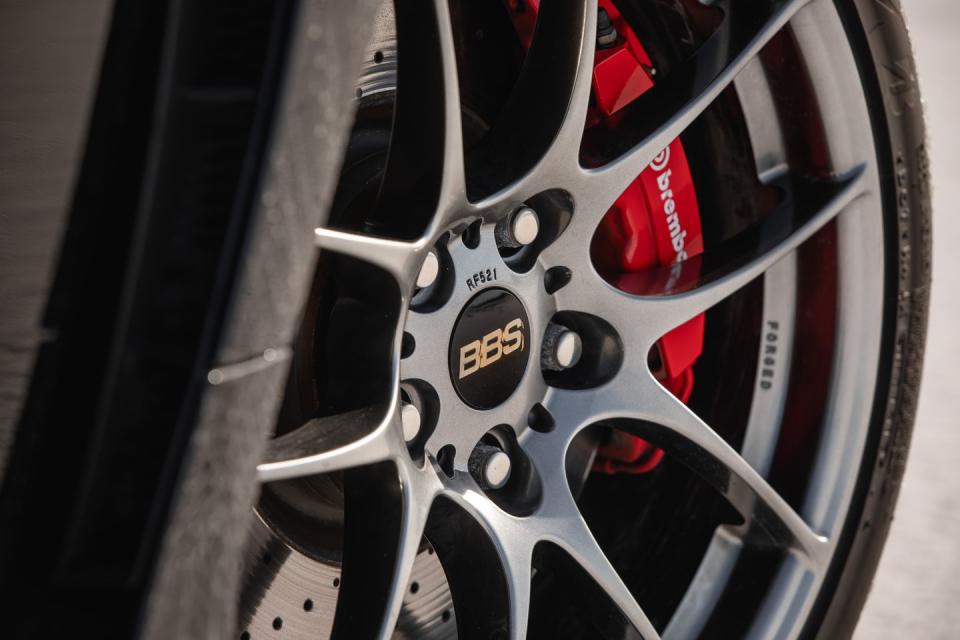
Our tire issues weren't over. As previously mentioned, Honda keeps the same service intervals on the Type R as it does any other Civic, which means oil changes happen about every 10,000 miles. Our car called for three, which totaled $369, over the course of the loan, and we never once had to add oil. But on the Type R, that's too long to wait to rotate the tires. We burned through the other front tire—the one that didn't eat a pothole—at 8900 miles, a new record in tire wear for our long-term fleet. However, if you rotate the tires every 5000 miles, they should be able to stretch to 15,000 miles. This sent us looking for aftermarket options.
We knew going in we had strong feelings for the Type R. After all, it's our reigning hot-hatch champ, first beating the Ford Focus RS and then the Hyundai Veloster N in separate head-to-head comparison tests and ascending to our 10Best podium in both 2018 and 2019. That ecstasy fades somewhat, however, when the steering wheel stays straight and the speed steady. On long highway trips, we complained about the short gearing (3200 rpm at 80 mph in sixth) and the boomy exhaust; we also struggled to break 30 mpg and 300 miles on a tank. On the other hand, the heavily bolstered seats proved to have incredible bandwidth and didn't become tiresome.

In some cases, it's the Civic-inherited equipment that disappointed. The infotainment system, for example, is woefully out of date. Honda has a newer, quicker-responding unit in much of the rest of its lineup. Also, the Type R doesn't have direct tire-pressure monitoring at each corner. Instead, it uses deviations in wheel speeds to sniff out a low tire. It regularly gave us false alarms, which, given our early tire wounds, induced panic each and every time. It didn't bother us that our car didn't have adaptive cruise—that was added for 2020—but the base cruise is about a decade behind. With no display of the set speed, drivers have to iterate toward their desired velocity with multiple button presses. Oh, how we suffer.
The most significant letdown materialized during a track day at the 1.9-mile GingerMan Raceway in South Haven, Michigan. In mid-80-degree temperatures, the Civic couldn't manage a single hot lap without running excessively hot and pulling power. It's no surprise that Honda increased the Type R's grille opening by 13 percent as part of its updates for 2020. That said, we brought along a 2020 model for comparison, and it didn't fare much better. The Type R just doesn't cope well with heat on short racetracks.

We did have a few other issues. The second-gear synchro sometimes walked out on the job, leaving us with nothing but a fistful of grind. In fairness, we did more than our share of quick-as-we-can acceleration runs during four separate testing sessions to get the numbers that accompany these words. Also, be careful when you grab that lever, as a metal shift knob is a scaldingly bad idea. And just a day before we parted ways, the transmission sometimes resisted going into first. We didn't have time to diagnose that, but Honda says we'd be on the hook for $800 to tear it down to determine if it's covered under warranty. Also, the height-adjustment lever on the driver's seat started clunking when we pushed it down. Fixing that would have cost $1359 for a new seat frame, as the dealer determined it wasn't covered under warranty. Lastly, we had a moaning clutch hydraulic line that was fixed with a simple adjustment.
Clearly, our Civic Type R, number 26,267 produced globally since 2017, was far from perfect, but it remains one of the purest-driving new cars for sale today at any price. Please, Honda, we beg of you, don't wait another 16 years before bringing us another R.

Rants and Raves
Every time I drive the Type R, it blows me away. I freaking love this car. —Jared Gall
It's hard not to feel like a tool when you get to your destination and look back at what you arrived in. —Mike Sutton
The Type R's luster fades on a road trip. There's a ton of road noise, and I wish the exhaust wasn't so boomy. —David Beard
The last time a front-wheel-drive car was this interesting, the calendar read 1960. —Eric Tingwall
Light, tight, and outta sight. I miss chuckable cars like this. —Eddie Alterman
Why does everyone with a V-8 want to race me? —Connor Hoffman
The blindingly red, deep front buckets are supportive and comfy. —Eric Stafford
I keep looking at my palm to check if I can make out the shift pattern burned into it. —Austin Irwin
Rubber Bands
The Type R's ultralow-profile 20-inch Continental tires let us down, so we went in search of an alternative that would improve pothole resistance while matching the performance of the factory tire. We first selected a set of 18-inch BBS RF521 wheels and wrapped them with one of our favorite tires: Michelin's Pilot Sport 4S. The ride improved noticeably, the tires dancing over rough patches and quelling the heart-stopping hits that came with sharp impacts. The Michelins delivered cornering and braking performance on par with the Contis while boosting highway fuel economy by a dramatic 3 mpg. Based on the wear over 6500 miles, we anticipate they'd last 25,000 miles (versus 15,000 for the Contis). But this lighter setup didn't launch off the line as well, and the 60-mph time slipped by three-tenths. So we tried a more extreme option: Pirelli's P Zero Trofeo R. These tires improved the Civic's 60-mph time, cornering grip, and braking performance compared with the factory setup. While a little harsher than the 18-inch Michelins, the Pirellis were far more comfortable than the original 20s. Plus, both tires are cheaper and quieter. Mission accomplished. —DV


30,000-Mile Update
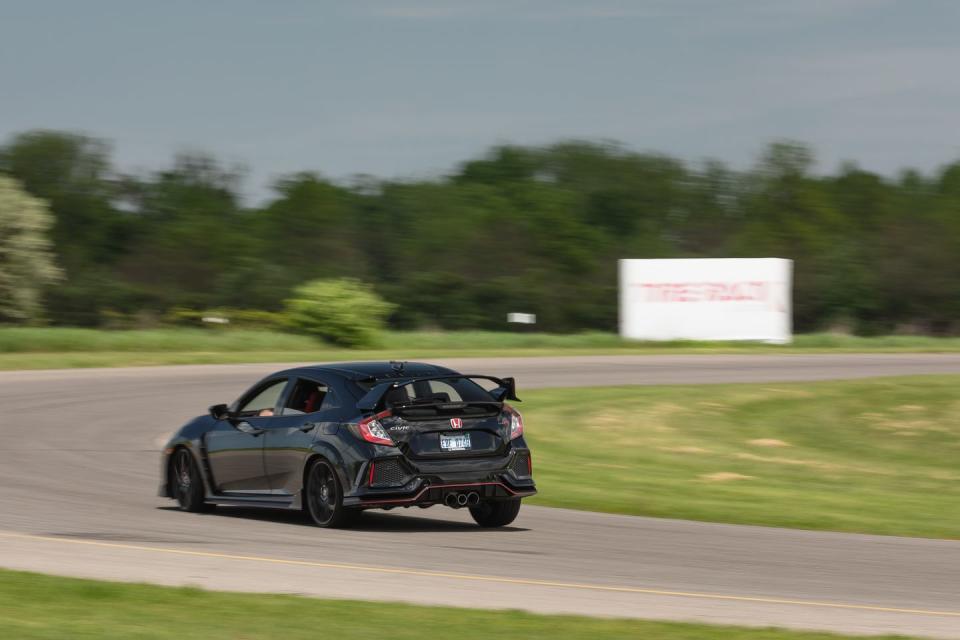
After months of winter and pandemic quarantining, we were especially in need of the kind of emotional cleanse that driving the meanest Honda Civic delivers. Staff editor Austin Irwin voiced what many of us were thinking: "Driving the Type R lifts spirits. Three hundred six horsepower of antidepressant. I'm totally abusing my prescription, and it feels fine!" (Ask your doctor if Type R is right for you.)
Speaking of a heavy dose, once spring hit we wanted to fully excise the cobwebs with a track day, so we trekked over to GingerMan Raceway in South Haven, Michigan. That's where we ran headlong into the Type R's shortcomings.
Initially we were once again won over by the Type R's massive front-end grip and impressive chassis balance for a front-wheel-drive car. These are the same qualities that let it shine at our annual Lightning Lap track test, where the Civic Type R still holds the title of the fastest front-drive car we've ever run.

However, in the low- to mid-80-degree temperatures at GingerMan, the Type R's engine temperature gauge quickly shot into the danger zone—and we could feel it noticeably lose power—while running a single hot lap with multiple cool-down runs in between. The car also flashed a check-engine light and went into limp mode, logging a P0087 fault code for low fuel-rail pressure. We suspect that bit came about because the fuel tank was getting low, and after clearing the code all was well again.
We had none of these issues at Virginia International Raceway during our Lightning Lap event but suspect that GingerMan's shorter length and lack of high-speed sections provide less cooling airflow to the Type R's powertrain. We couldn't help but notice the Volkswagen Golf R and Ford Focus RS that were also at this track day weren't having the problems we were. This is not a new complaint on Type R owner's forums, and it's no surprise that Honda increased the grille opening by 13 percent to improve cooling as part of the Type R's updates for 2020.
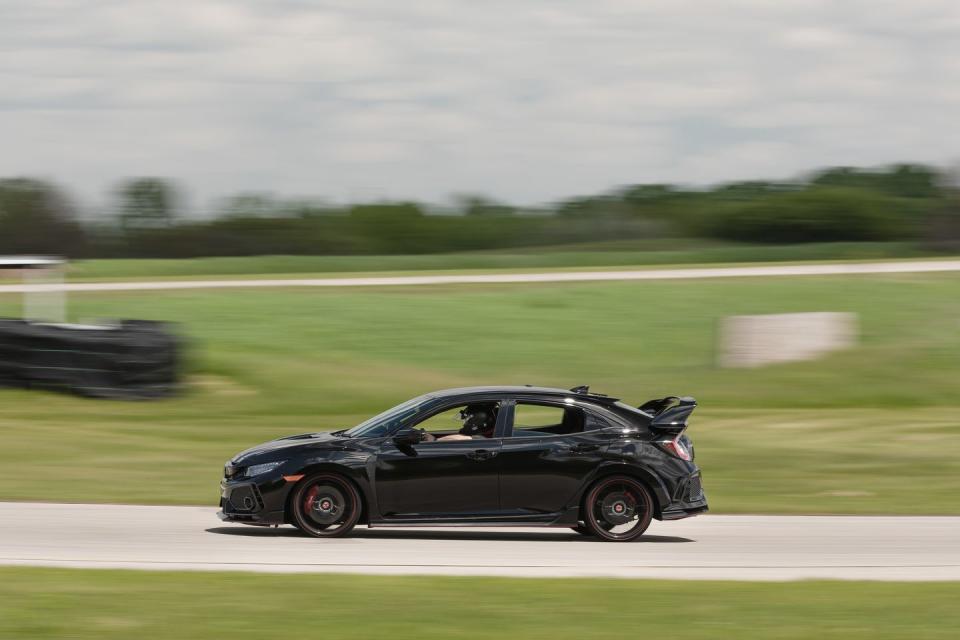
Away from the rigors of the track, we've made it as far south as St. Louis in the past 10,000 miles and as far east as Greenwich, Connecticut. But the majority of our miles have been close to home. With the odometer now showing 31,217 miles, our Civic's oil-life monitor still says we have 15 percent left before the next service, even after driving nearly 10,000 miles since our last visit at 21,430 miles. That means since our last update six months ago, we have yet to spend another dollar on service. Or, more impressive, we haven't damaged another wheel or worn through another tire.
Months in Fleet: 14 months Current Mileage: 31,217 miles
Average Fuel Economy: 25 mpg
Fuel Tank Size: 12.4 gal Observed Fuel Range: 310 miles
Service: $221 Normal Wear: $989 Repair: $0
Damage and Destruction: $2012
20,000-Mile Update
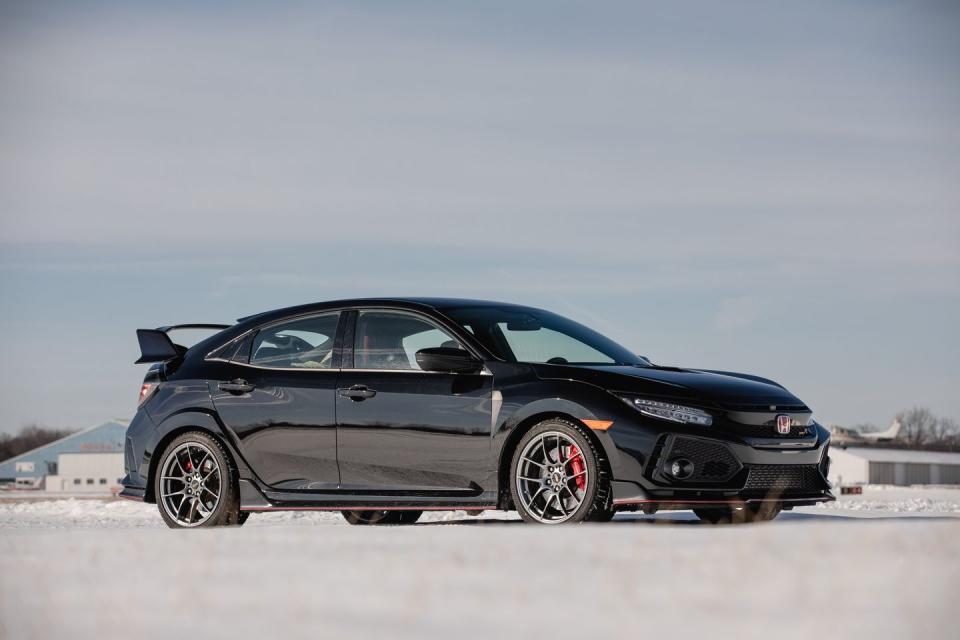
The latest Type R is demonstrably great in many ways. But one thing missing from its hot-Honda lineage is that it isn't built in Japan. It rolls off the line in England and the engine is bolted together in Ohio, making the six-speed manual transmission the only major subassembly that originates in Japan. So we endeavored to bring some additional JDM cred to our vociferous black hatchback with a set of winter wheels and tires. Plus, given our previous issues in this area, we wanted to downsize from the ultralow-profile factory 20-inch rolling stock. We landed on BBS's RF521 single-piece 18-inchers and Bridgestone's newest and gnarliest Blizzak WS90 tires, both of which are made in Japan.
A bonus is that the gorgeous forged aluminum BBS wheels weigh just 18 pounds apiece; that's a significant 38 percent lighter than the factory 20s. At $800 each, they cost less, too. (We had to shell out $1300 to replace a bent factory wheel.) Although the additional lightness doesn't help one bit with avoiding wheelspin when accelerating from a stop, the Type R's ride quality—which is impressive even on the aggressive stock setup—is now less severe. We don't care for the squishy way the ultrastiff Civic corners with the soft Blizzaks on dry roads, but you can feel the payoff when they get to sink their sipes into snow- and ice-covered roadways. We've had these wheels and tires on the Civic for two months now and covered some 3000 miles, and we're happy to report that they've thus far fended off Michigan's notoriously vicious potholes. Overall, our car still feels impressively tight and rattle-free, even in these cold winter months when interior-assembly issues often make themselves known.

At just over 21,000 miles, we took our car in for its second service, or "B1" in Honda parlance, which includes an oil change, a tire rotation, and various inspections. It cost us $163. That means we've spent just $221 so far on service. That said, we've spent almost five times as much on what we call "normal wear" for the Civic, as we had to replace its original tires by 19,000 miles. (The cost for one of those tires—the one we lost to a pothole—goes under "damage and destruction," an area where we've spent even more.)
Our affection for driving the Type R is more of an "in small doses" type of love, as the car's short gearing, boomy exhaust, and relatively limited range don't make it the staff's first choice for long highway slogs. However, it has made a couple significant journeys in the last 10,000 miles: a 1000-miler to the far western edge of Michigan's Upper Peninsula and a 1300-mile jaunt to Greenwich, Connecticut.
Months in Fleet: 8 months Current Mileage: 22,297 miles
Average Fuel Economy: 25 mpg
Fuel Tank Size: 12.4 gal Observed Fuel Range: 310 miles
Service: $221 Normal Wear: $989 Repair: $0
Damage and Destruction: $2012
10,000-Mile Update
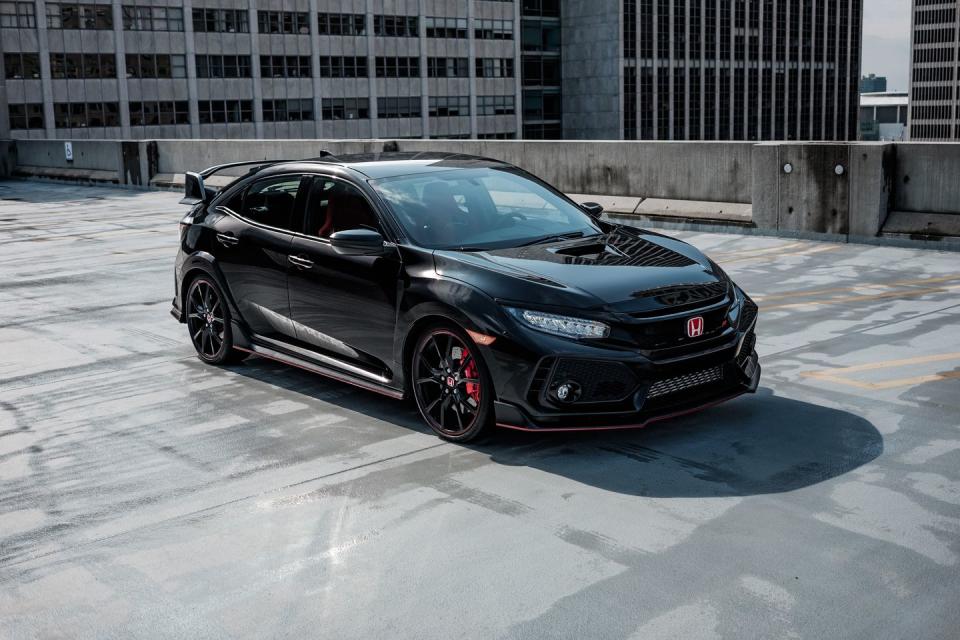
How much do we love driving the Honda Civic Type R? Deputy features editor Jared Gall summed up the ultimate Civic's pure steering, hypersharp brake pedal, and all-around dynamic rightness in just two carefully chosen words: "F**k me."
And we have indeed found ourselves, uh, screwed from time to time by our fiery hatchback, with nearly all its issues being of the round and black variety. We've already covered that in its first month, a pothole ended a front wheel and tire; less than two weeks later, we discovered a nail in that brand-new tire, which a local shop patched for $31.

At 8873 miles, the front tire that hadn't been replaced was completely worn, a record in burning through rubber in our long-term fleet. So we ordered a $304 replacement from Tire Rack. While mounting this new tire and rebalancing and rotating the others, we discovered that the other front wheel was bent. We had that one straightened for $150.
All of this happened before even the first scheduled service at 10,000 miles, a simple $58 oil change and inspection. That service also calls for a tire rotation, but Honda should really program a specific service schedule for the Type R that calls for tire rotations every 5000 miles, rather than the Civic norm of 10,000. Doing that may have extended the extra-short life of our front tire to 15,000 miles.
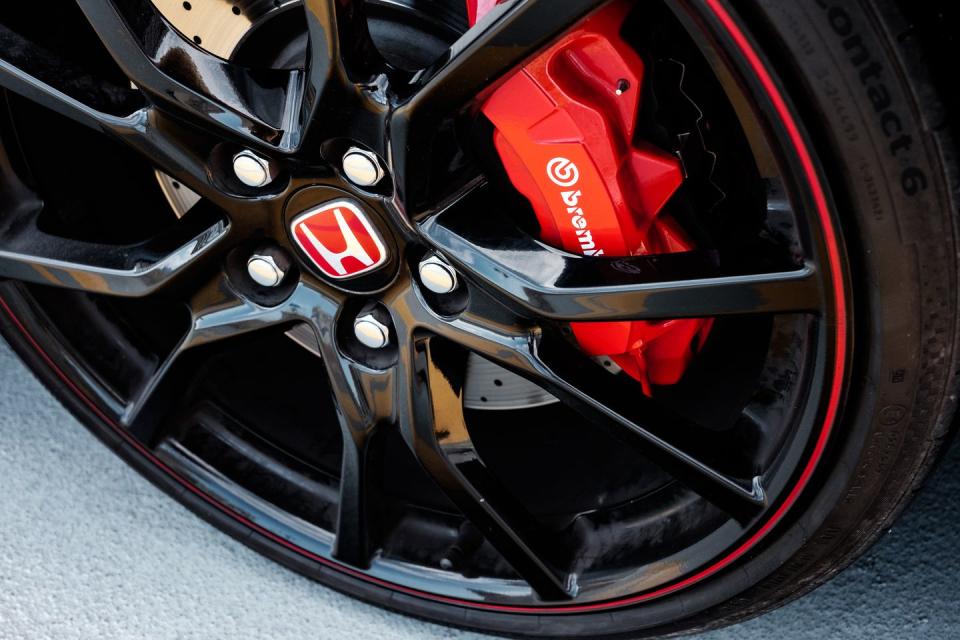
We can't help but notice that the Civic's long-term stablemate Hyundai Veloster N has not had a single wheel or tire issue; perhaps its 0.02-g-less cornering grip and 11-foot-longer stopping distance from 70 mph are worth the trade-offs of longer life and less susceptibility to damage. We're definitely planning to downsize the Civic's wheels and upsize the tires' sidewalls when we procure our winter-tire setup.
Nits to Pick
The only other issue of significance has been false low-tire-pressure warnings. Unlike most new cars today, which monitor pressure directly with a sensor on each tire, the Civic uses a less expensive approach that closely observes individual wheel speeds to sniff out low pressures. (Low pressure causes the diameter of that tire to be slightly smaller and thus rotate slightly faster than the others.) But on multiple separate occasions, the alert flashed, which caused panic, given all the tire issues we've had. We'd stop and check the pressures, and all was well, so we'd reprogram the system and head on our way.
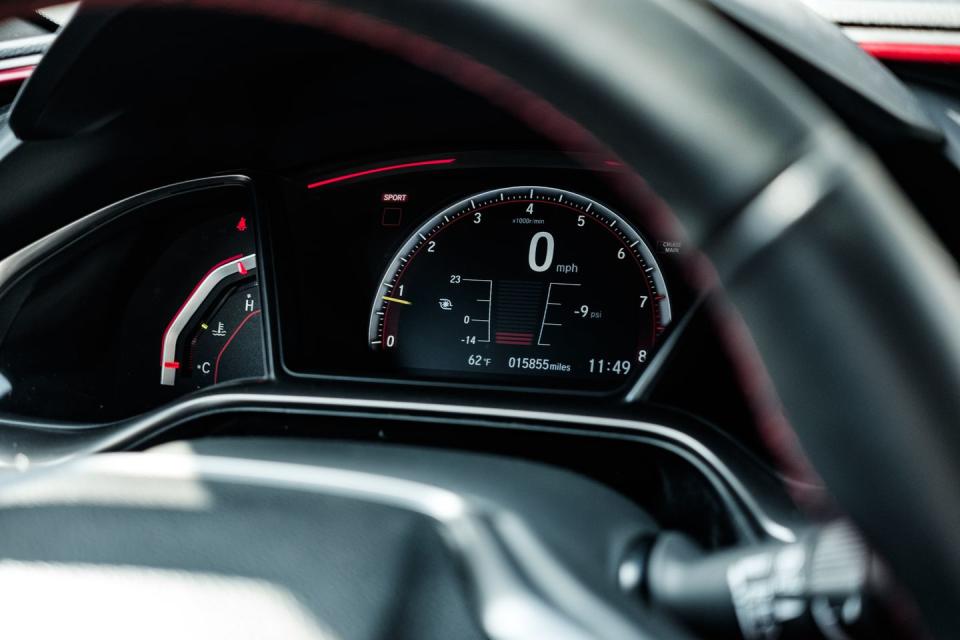
The Type R has mostly stayed local, other than the visit to Peter Cunningham's collection of Hondas near Milwaukee, Wisconsin, and a 1200-mile trek down and back to this year's Lightning Lap track test at Virginia International Raceway. The Civic's average fuel economy remains 25 mpg.
Complaints about the Type R have centered on its uninspired exhaust note—drawing comparisons with the livelier Veloster N, which relies on active exhaust flaps to make its music—the stereo's sound quality, and that the Civic is still soldiering on with Honda's outdated infotainment, rather than the much-improved system in its newer vehicles. Someone even took issue with the Type R defaulting to its Sport driving mode rather than Comfort, but he's wrong.
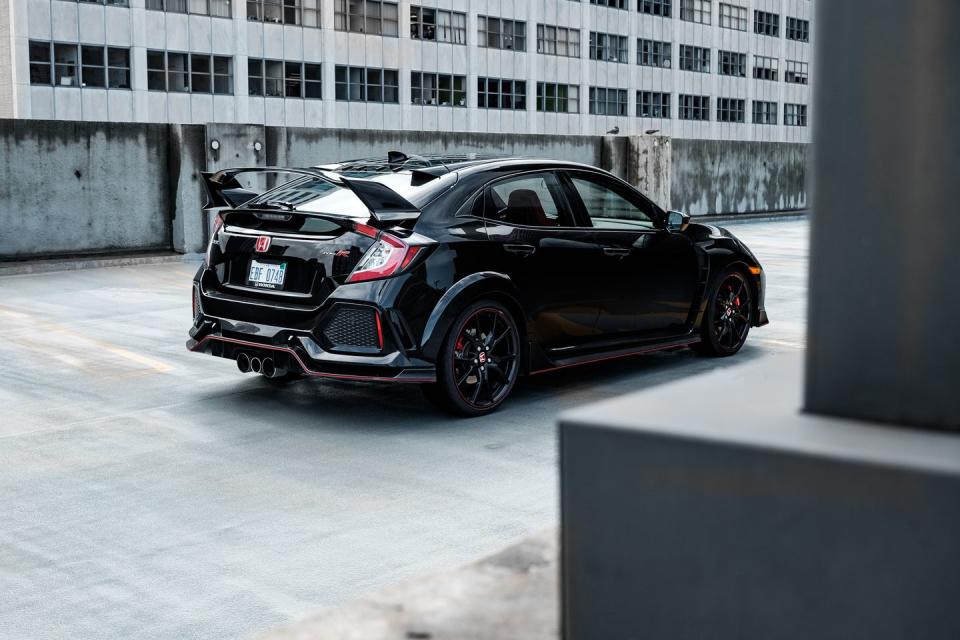
It also feels as if the second-gear synchro might be starting to resist our most aggressive advances; we're going to continue to monitor that as we carefully choose a path along our crumbling roads.
Months in Fleet: 3 months Current Mileage: 10,838 miles
Average Fuel Economy: 25 mpg
Fuel Tank Size: 12.4 gal Observed Fuel Range: 310 miles
Service: $58 Normal Wear: $329 Repair: $0
Damage and Destruction: $2012
Introduction

The owner's manual for the 2019 Civic Type R sure doesn't make it seem special, despite the 306-hp state of tune for its turbocharged 2.0-liter inline-four—which makes 252 horsepower in the Accord—and spring rates that are, astoundingly, 200 percent stiffer in front and 160 percent firmer in the rear than those on a base Civic. Remarkably, there's no Type R–specific service schedule or break-in period. It's the same, vague "avoid sudden acceleration or full-throttle operation" for the first 600 miles and an admonition to "avoid hard braking" for the first 200 miles.
But that's part of the allure of the high-performance Hondas that we've loved. There's a duality to them—the ability of the chassis, and especially the engine, to loaf along in a manner that wouldn't raise suspicions of unknowing drivers, but then to absolutely come alive the harder they're pushed and to be nearly equal parts invigorating and reliable.
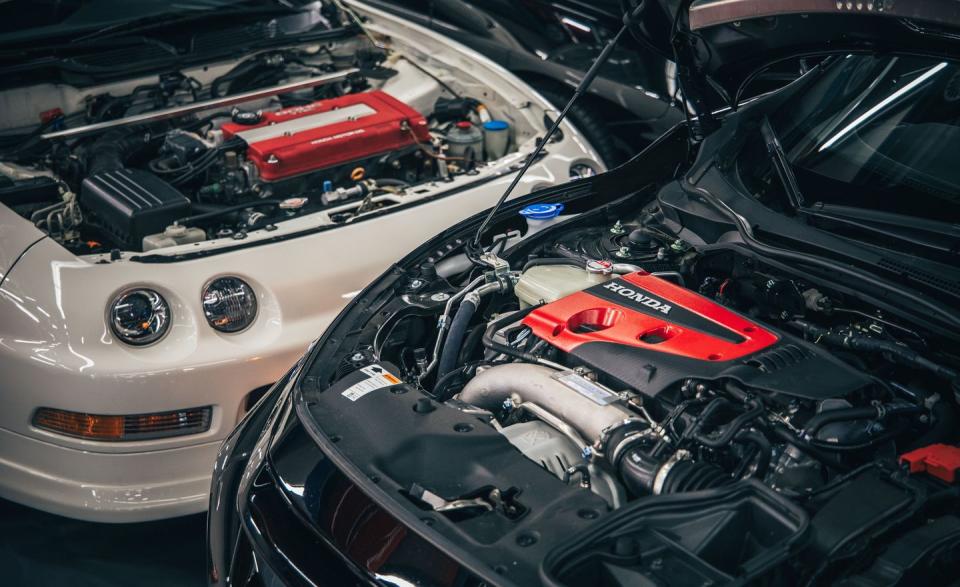
And the Type R can push better than the rest, defeating first the Ford Focus RS, then the Hyundai Veloster N in head-to-head comparison tests and winding up on our 10Best Cars list two years running. It also set the quickest lap time we've ever coaxed out of a front-wheel-drive car during our 2018 Lightning Lap track test.
To indoctrinate our long-term Type R, number 26,267 sold globally thus far since its 2017 introduction, and to make sure it properly understands its roots, we went on a history field trip to the RealTime Racing Collection Hall in the greater Milwaukee, Wisconsin, area. RealTime is Honda and Acura's longtime factory racing partner, and this collection of 50-plus cars has been masterfully assembled by its founder, an extremely successful driver and a genuinely nice guy, Peter Cunningham. The day we visited, June 11, held special importance, too, as it was 60 years to the day since Honda started operating in the United States.

The Red Honda Badge
This Civic Type R is only the second-ever vehicle in the U.S. to wear the coveted red badges, sharing this honor with the 1997–2001 Integra Type R. Cunningham, naturally, has examples in every available color. He started assembling this sprawling tribute to Mother H in 2013, and when the cars started overflowing existing stash space, he acquired the warehouse pictured here. To complete the theme, he created an exacting replica—down to the two-piece sign, window and downspout designs, and the 1960s Chevrolet Apache delivery truck parked out front—of the front façade of Honda's first U.S. headquarters in Los Angeles, as depicted in one of few surviving photos.
Although this latest Type R's turbo 2.0-liter can't match the stratospheric redlines of seminal Hondas past—along with a 9500-rpm 1966 S600 coupe, this collection houses an 8400-rpm Integra Type R, an 8900-rpm AP1 S2000, and an 8000-rpm NSX—it does follow some of the other traditions. Such as short gearing that makes the engine spin at 3200 rpm at 80 mph in sixth, making it difficult to achieve either 30 mpg or 300 miles on a tank. Though the latter is more than possible based on the math, Honda's notoriously conservative distance-to-empty readout makes pushing it an act of faith. Also, like the Integra Type R and S2000, this Civic has a metal shift knob that we'll surely be regularly cursing after the car is parked in the sun on a hot day.

The Type R's three-pipe exhaust is supposed to both amp up the noise when hammering the throttle and prevent droning at steady rpm, but it doesn't succeed at either task. It makes a loud but uninspiring sucking sound at wide-open throttle and drones annoyingly while cruising at highway speeds. Overall, the cabin is quite noisy on the interstate, although we've found the aggressively bolstered seats to be perfectly comfortable for long-distance drives.
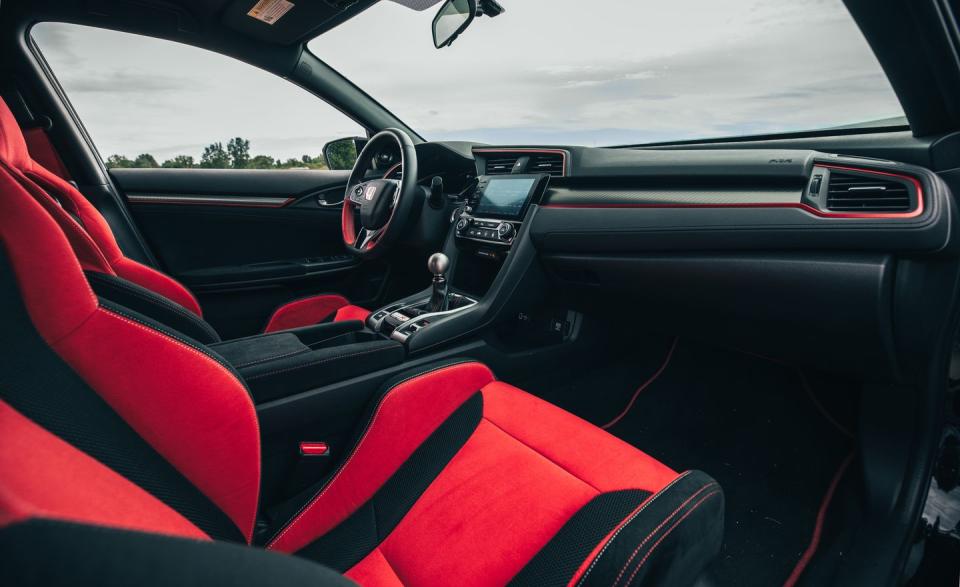
This latest Type R was a couple tenths slower to 60 mph than some of our previous test cars; it's a matter of whether or not it just kisses 60 mph before the two-to-three upshift. And the skidpad grip wasn't quite as tenacious, coming in at a still-strong 0.99 g.
Updates for 2019
The 2019 model has a few minor updates, including additional hard buttons to control the radio as well as a volume knob. Also added this year is a USB extension cord, likely in response to what we're sure was overwhelming feedback from Civic buyers who didn't appreciate having to snake their cable to the upper deck of the center console, which is the natural resting place for a phone.

Usually we have spirited arguments about automotive aesthetics, but it's hard to find supporters of the Civic's jumbled exterior that teems with surfaces and addenda. That's how we settled on black exterior paint, to better mask its exterior busyness. Other than color, there are no factory options for the Type R, although there are more than a few dealer-installed extras that we passed on, including, shockingly, additional body cladding.
Road-Trip Life
On the way to the Milwaukee mecca, we took the Lake Express ferry across Lake Michigan—impressively, its cruising speed approaches 40 mph—to shortcut Chicago traffic. We should have done the same when headed home because, unfortunately, on the 340-mile drive back, we found the limits of the Type R's extraordinarily narrow sidewalls. Its 245/30R-20 Continentals imply a nominal 2.9 inches of sidewall, which was not enough to survive a wincing pothole impact.
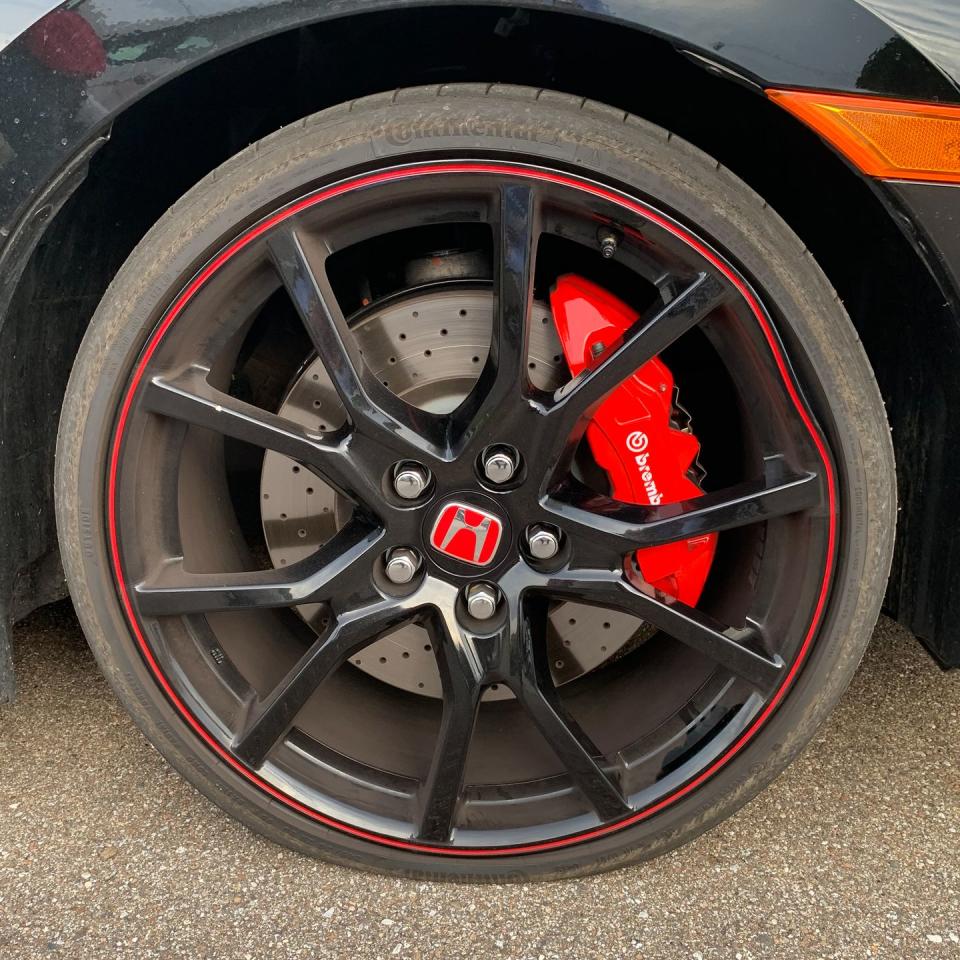
Pulling off at the next exit to survey the damage, we still weren't certain that it was flat. That's because in our first month with the car, we had experienced numerous false alerts from the tire-pressure-warning system, and it had even activated earlier in the drive. We were surprised in equal measure by how squared off the wheel was and that the tire was still holding 8 psi of pressure. In these no-spare-tire times that we live in, we were stranded overnight, but to our great fortune, the exit that we limped to in western Michigan happened to have a Honda dealership immediately adjacent to a hotel. With a new $1307 wheel, a $296 tire, plus mounting/balancing and a four-wheel alignment, we were back on the road two days later for—ouch—$1831. We sure hope this isn't the start of a trend.
Months in Fleet: 1 month Current Mileage: 4522 miles
Average Fuel Economy: 25 mpg
Fuel Tank Size: 12.4 gal Observed Fuel Range: 310 miles
Service: $0 Normal Wear: $0 Repair: $0
Damage and Destruction: $1831
You Might Also Like

 Yahoo News
Yahoo News 